Archives
-

Generative AI in Nordic higher education: cases and pedagogical implications
Vol. 18 No. 31 (2025)Editor: Inger-Marie Falgren Christensen, imc@sdu.dk, University of Southern Denmark
Editor: Marianne Georgsen, mage@via.dk, VIA University College
Editor: Mikkel Godsk, godsk@au.dk, Aarhus UniversitySince the launch of ChatGPT3 on November 30, 2022, the use of generative artificial intelligence (GenAI) in the form of large language models (LLMs) such as ChatGPT, Copilot, and Gemini has grown significantly. Teachers, supervisors, and students can now get help in producing not just text, images, and video, but also analyses, syntheses, summaries, calculations, etc. GenAI also appears in roles such as sparring partner, feedback provider, and teaching assistant.
A plethora of webinars, conferences, and courses on GenAI are being held, and many texts (articles, books, reviews, reports, blog posts, etc.) have already been published discussing the potentials, limitations, and challenges associated with the use of GenAI in higher education contexts. The use of GenAI in pedagogical practice in higher education is as a research field not yet consolidated. The current research points in different directions and presents different conceptualisations. For example, empirical research on the significance of GenAI technologies for higher education is severely limited and focuses primarily on attitudes towards the technology or measurement of the quality of its answers.
-
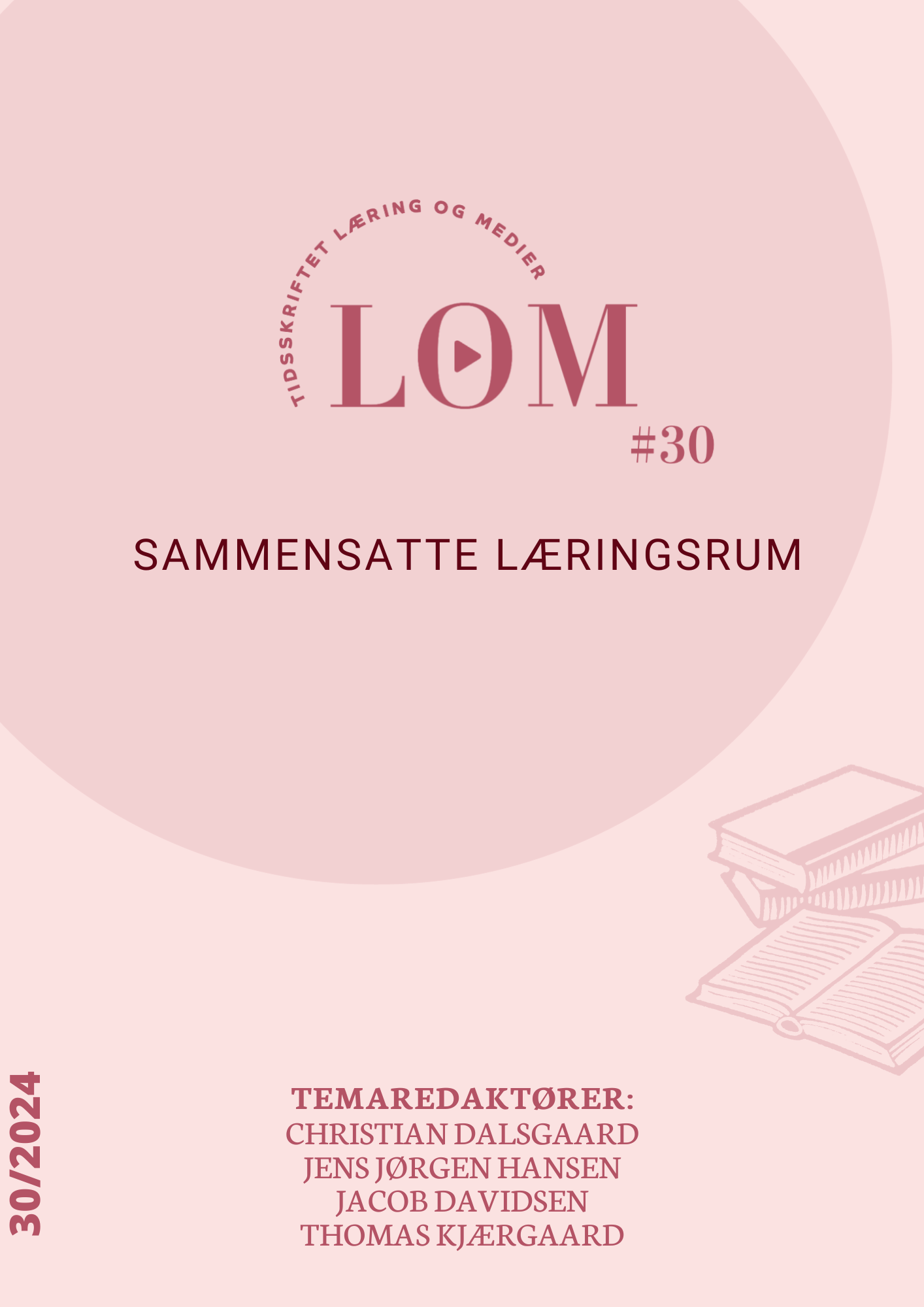
Integrated Learning Spaces
Vol. 17 No. 30 (2024)Editor: Christian Dalsgaard, cdalsgaard@edu.au.dk
Editor: Jens Jørgen Hansen, jjh@sdu.dk
Editor: Jacob Davidsen, jdavidsen@ikp.aau.dk
Guest editor: Thomas Kjærgaard, TMK@ucn.dkNew forms of integrated learning spaces and teaching methods are beginning to become a reality at many educational institutions. In recent years, the post-digital perspective has gained ground in the field of using digital technologies in education. The post-digital perspective does not separate the digital as something distinct but rather considers it as part of the infrastructure of education. At the same time, the post-digital perspective challenges the mantra of "pedagogy first," as it does not prioritize either the digital or pedagogy. Instead, it views pedagogy and technology as interwoven, and this interweaving can contribute to the creation of entirely new educational formats, teaching methods, and study practices.
In this special issue of the Learning and Media Journal, we aim to focus on how new forms of learning spaces transform (and have transformed) teaching practices and students' practices through the composition and integration of various technologies and spaces. This special issue is concerned with integrated educational formats, teaching methods, and students' integrated study practices, inviting articles on education, teaching, and learning.
This special issue asks whether the post-digital perspective is correct. Can we avoid doing the pedagogically same and instead move pedagogy to new places through the integration of digital technologies into new formats? And how?
In this context, the special issue is particularly interested in studies of examples of pedagogical innovation in practice. What are the educational potentials in new integrated formats, study practices, and forms of collaboration? Can we finally move beyond whether something is "digital" or not and start focusing on how to develop new forms of education that enhance student learning, address new target groups, etc.? Such considerations also entail rethinking what learning spaces are and beginning to develop new understandings of learning spaces.
The special issue subscribes to a broad understanding of integrated learning spaces, which can include synchronous hybrid classroom teaching, blended courses, students' working and collaboration methods, and more.
-
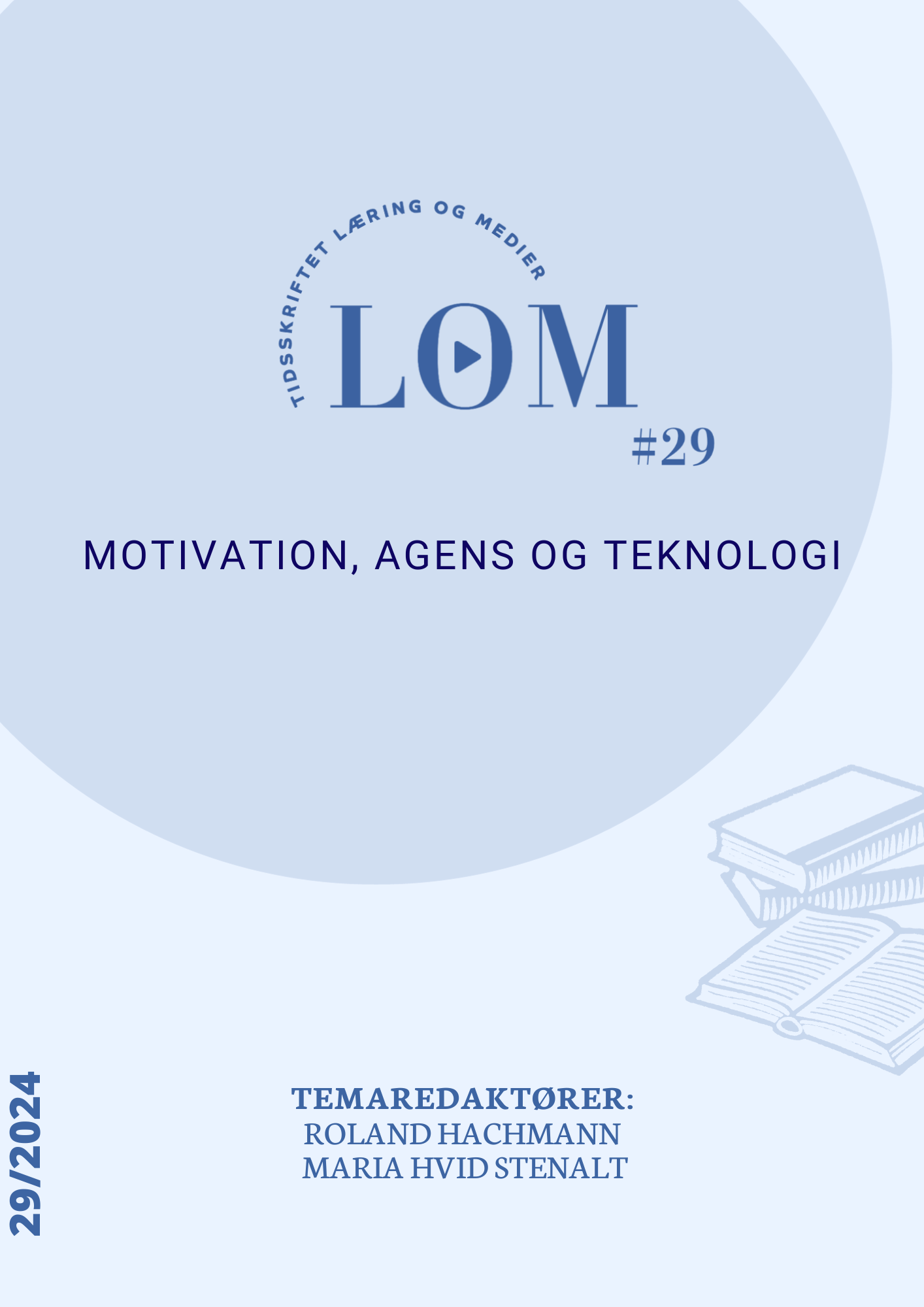
Motivation, agency and technology
Vol. 17 No. 29 (2024)Editor: Roland Hachmann, rhac@ucsyd.dk, UCSYD
Editor: Maria Hvid Stenalt, mariahs@ikl.aau.dk, Aalborg UniversityHow do digital technologies and technology-enhanced teaching support students' agency or ability to act? Can a digital environment be designed to support student agency at all? How does our thinking about students' agency affect the digital environments and technologies purchased for technology- supported teaching? What agency do teachers have in technology-supported teaching? What motivates them to use digital technologies, and how can their motivation be increased with regard to integration? What happens in a digital environment where students are not motivated to participate? What characterizes such an environment?
In this issue of LOM, we are interested in contributions that focus on the relationship between digital technologies and environments, and teachers' or students' motivation or agency. We are open to research articles that theoretically and empirically examine and critically-constructively relate to these connections at the micro, meso, or macro level, particularly in higher education. Articles can be based on existing research and cases, evaluations of effects and quality in relation to educational challenges, didactic innovations, and experiments that in various ways relate to motivation, agency, and digital technologies.
-
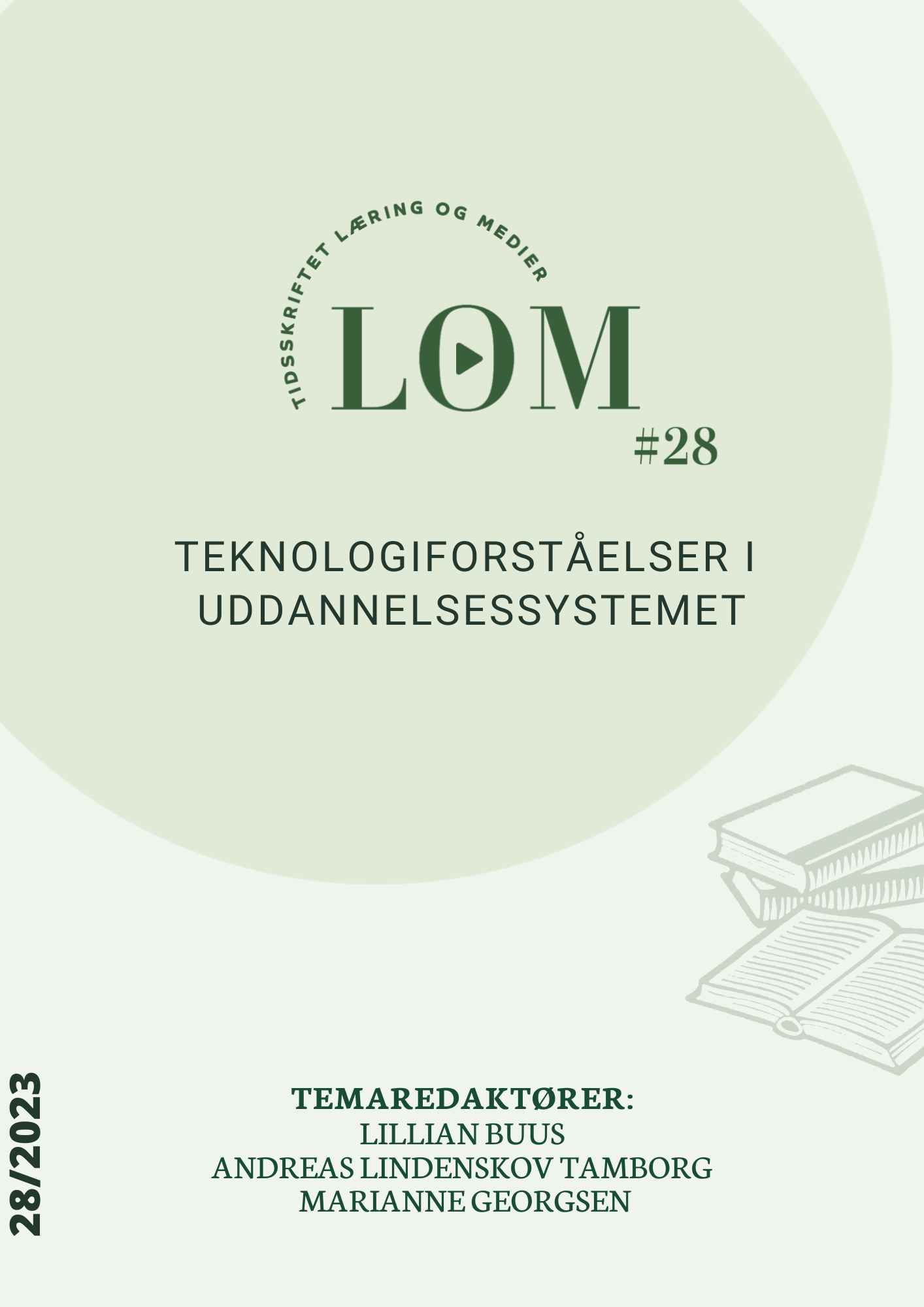
Technology comprehension in Education
Vol. 16 No. 28 (2023)Editor: Lillian Buus, libu@via.dk, VIA University College
Editor: Andreas Lindenskov Tamborg, andreas_tamborg@ind.ku.dk, Copenhagen University
Editor: Marianne Georgsen, mage@ucn.dk, University College NorthIn a Danish context, the term technology comprehension is often used to denominate the subject domain that has been and must be developed to provide educational answers to some of the challenges posed by the increasing digital development. This concerns the opportunities for citizens to participate in an increasingly digitalised society, the competencies of employees to enter into job functions in a digitalised labour market as well as a potential need for development with regards to the contents of study programmes and curricula. In recent years, there has been a growing interest in technology comprehension as subject domain across more or less all levels of the Danish education system: day care, primary and secondary school, vocational education as well as higher education. It is this particular subject domain and its development which is one of the themes of this call. The other theme is the organisational capacity building that exactly this or these emerging subject domain(s) call for. In this issue, we welcome contributions that address both issues. Likewise, contributions can provide overall insight into the extent to which the subject domain and the capacity building can be understood independently of each other (or not).
The appearance within the educational sector of subject domains and concepts related to technology comprehension has given rise to growing research interest in technology comprehension that, among other things, is expressed via special issues on technology comprehension in the journals Unge Pædagoger (Young Pedagogues), Learning Tech, and Studier i Læreruddannelse og Profession (Studies in Teacher Education and Profession). This had led to research within a long series of phenomena, issues and challenges related to analyses and discussions of new technology comprehension subject domains as these have been described in official documents, as they appear in digital learning resources as well as the roles of these subject domains in higher education, youth education and vocational education. What is common for these substantial contributions is that they often zoom in on technology comprehension as it is practiced in a specific educational or subject-related context.
In addition, in recent years, subjects, subject domains and capacity building in relation to technology comprehension have been developed within educational contexts. Among these developments are the TEK (TECH) experiment in primary school, the informatics subject at STX (the Higher General Examination Programme), development of the TEKU-model in relation to select profession-specific study programmes, the Teknosofikum project in higher education.
-
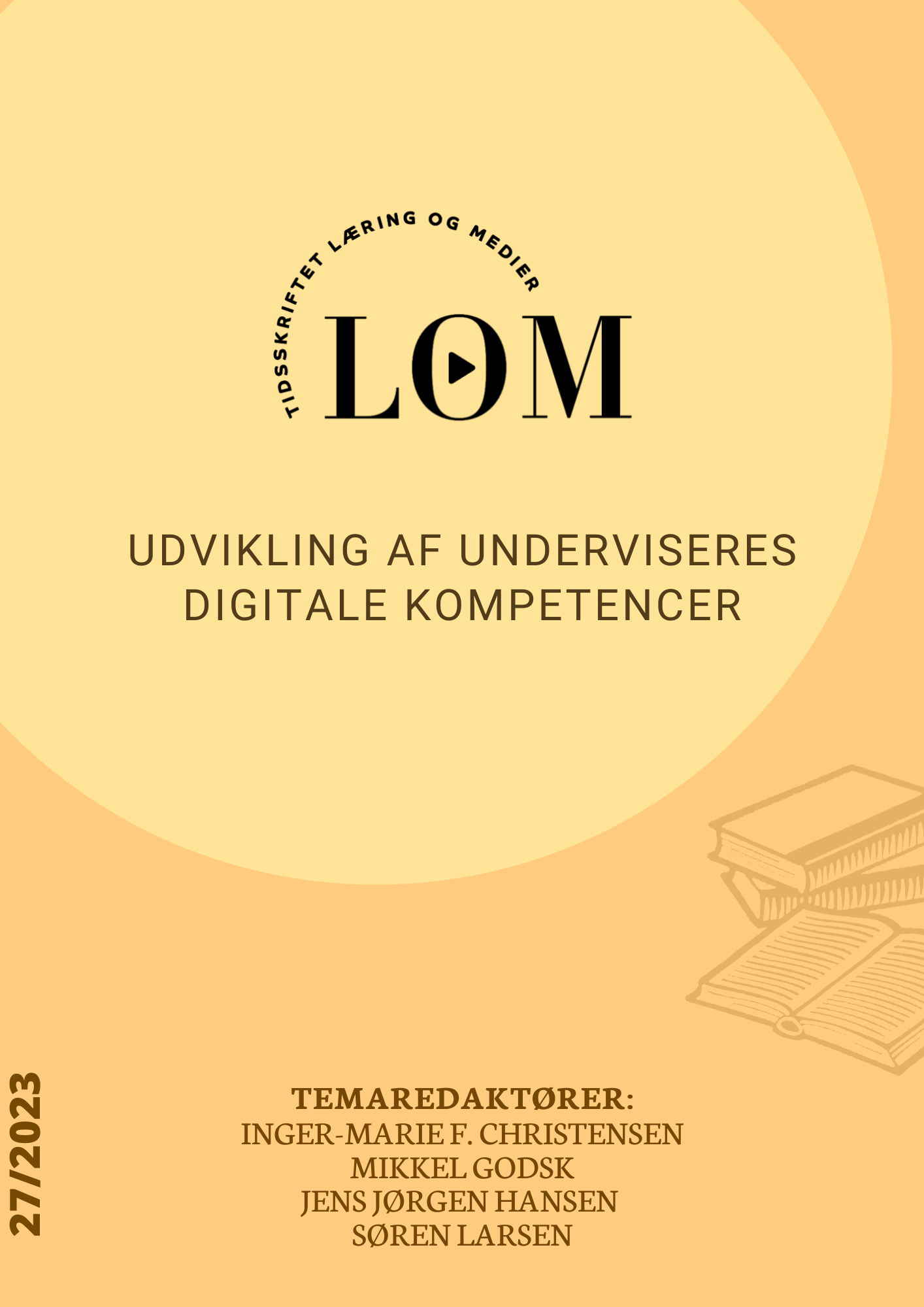
Developing teachers’ digital competences
Vol. 16 No. 27 (2023)Editor: Inger-Marie F. Christensen, imc@sdu.dk, University of Southern Denmark
Editor: Mikkel Godsk, godsk@au.dk Aarhus University
Editor: Jens Jørgen Hansen, jjh@sdu.dk, University of Southern Denmark
Editor: Søren Larsen, slars@ruc.dk, Roskilde UniversityHaving focused on the procurement and implementation of learning technologies and platforms for several years, higher education (HE) institutions are now concentrating their attention on the optimal deployment of these technologies. In this connection, the development of HE teachers’ digital competences, including the ability to utilise digital (learning) technologies in teaching and to develop and carry out technology-enhanced teaching, is a top priority on both HE institutions’ as well as political agendas. This is illustrated in for example the ministerial Call for Action: Technological upgrade of higher education (2018), the subsequent national action plan Digital competences and digital learning (2019) on the development of teaching and teachers’ competences, institutional strategies, local action plans and efforts to promote professional technologies in subjects. Furthermore, there is an added focus on the quality assurance of teachers’ pedagogical competences in HE (at the universities this is illustrated by the Danish framework for advancing university pedagogy, 2021). HE institutions are thus busily engaged collecting knowledge on, creating, assuring the quality of and evaluating initiatives as well as developing methods that support teachers’ professional development in relation to digital competences.
-

Pedagogy and online teaching
Vol. 15 No. 26 (2022)Editor: Mikkel Godsk, godsk@au.dk, CED, Aarhus University
Editor: Roland Hachmann, rhac@ucsyd.dk, University College South Denmark
Editor: Christian Dalsgaard, cdalsgaard@edu.au.dk, Danish School of Education, Aarhus UniversityIn LOM #26, we focus on pedagogy and online teaching to explore how best to plan, carry out and evaluate online teaching. How is pedagogically grounded online teaching developed? How is the appropriate use of digital platforms and technologies secured where the full potential of the online format is realised?
Teaching during the Corona pandemic has given rise to rethink existing teaching formats, and new practices for online teaching have been established. In contrast to the teaching that focused on solving an acute need for distance teaching (often referred to as “Emergency Remote Teaching”), it is now (or should be) time for an actual transformation of teaching that takes the technological and pedagogical/didactical frameworks of the online format into account.
LOM #26 invites articles that present considerations on the online format and the pedagogic application of digital platforms and technologies, including design and development processes that can contribute to making visible the choices that must be made when planning online teaching. We are interested in articles that rethink, among other things, the pace of teaching, the teacher-student ration, pedagogy, roles, synchronicity and forms of assessment and feedback in relation to the online format.
-
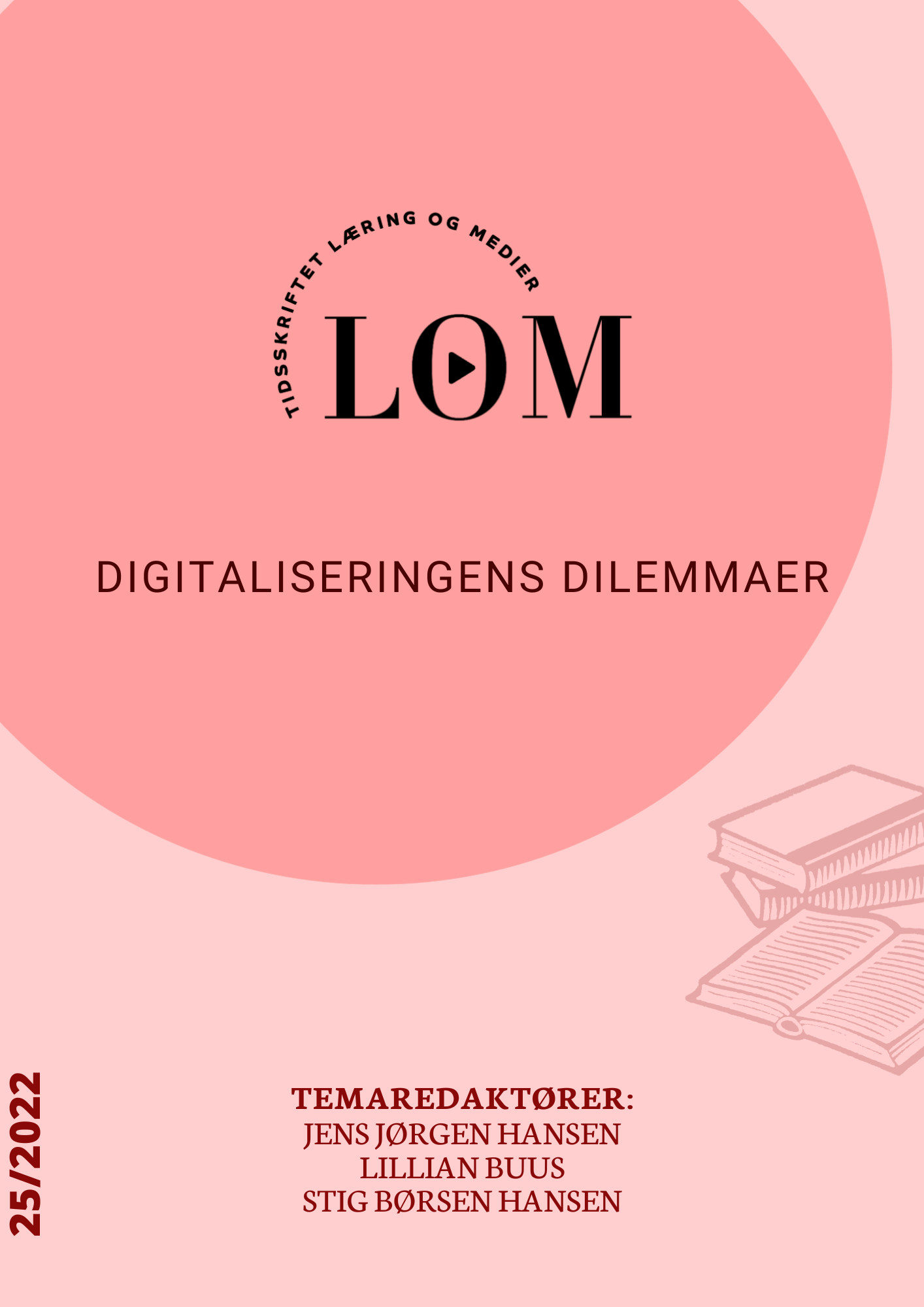
Dilemmas of digitisation
Vol. 15 No. 25 (2022)Editor: Jens Jørgen Hansen, jjh@sdu.dk, University of Southern Denmark
Editor: Lillian Buus, libu@via.dk, VIA University College
Guest editor: Stig Børsen Hansen, stbh@sdu.dk, University of Southern DenmarkIn this issue of LOM, we focus on the dilemmas, barriers and paradoxes that unfold when, to a still greater extent, teaching is digitised. Examples of dilemmas are when educational institutions select digital platforms which, in themselves, contain pedagogical possibilities and limitations. Or when educators develop teaching materials and encounter copyright challenges. When an educator team has developed a course and poses the question: who owns this material? When students in an assignment conduct interviews and questionnaire surveys and are faces with challenges in relation to GDPR issues such as consent, data storage and data processing or in other words, when the digital resource dictates the educational design.
The dilemmas of digitisation thus contain a broad spectrum of ethical and legal challenges as well as pedagogical, strategic and quality assurance dilemmas that are found at the institutional level as well as at the levels of teaching and learning.
This issue calls for case studies that investigate and elaborate on one or more dilemmas, barriers or paradoxes. Contributions should consider and discuss possible solutions to the dilemmas identified.
-
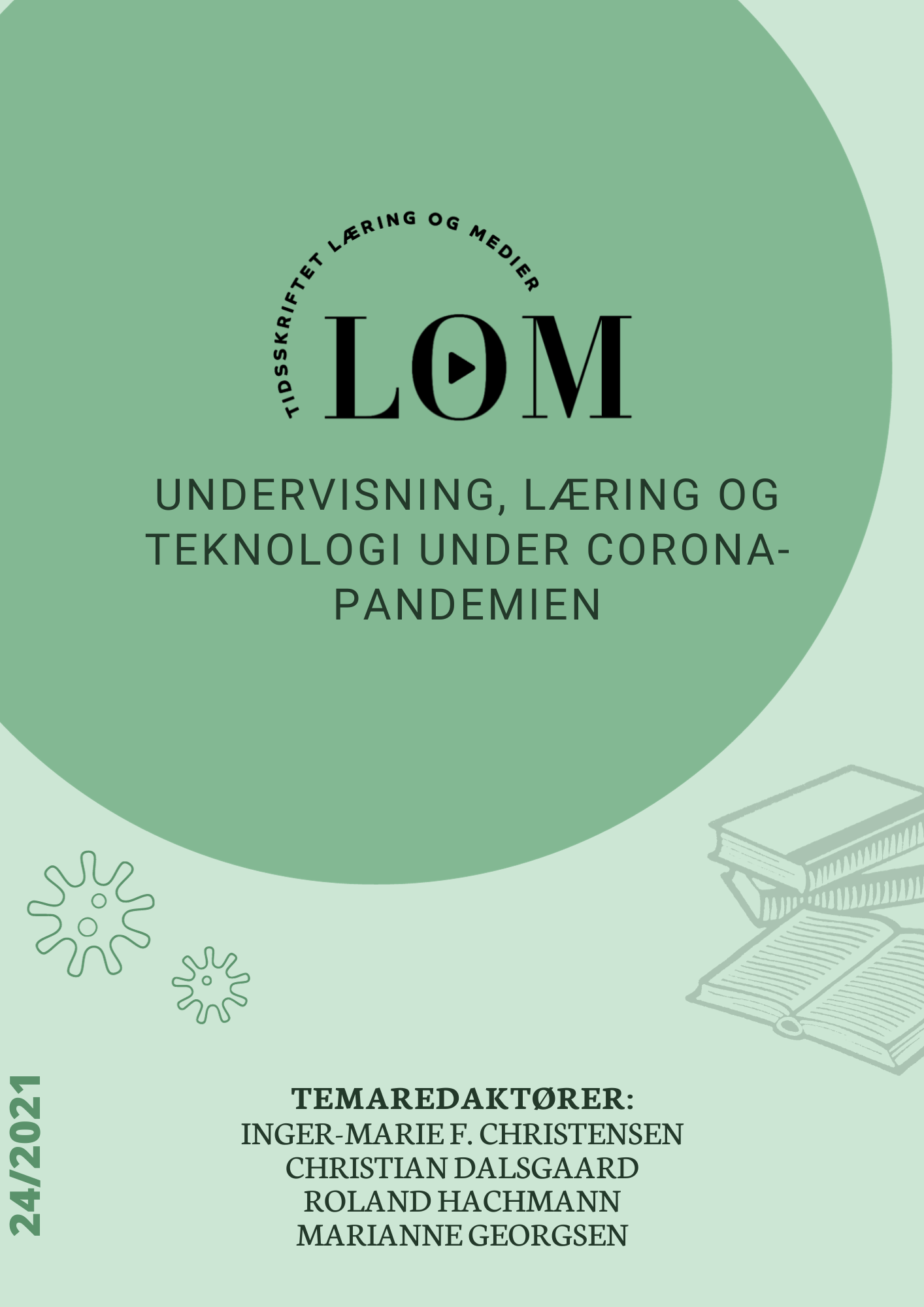
Teaching, learning and technology during the Corona pandemic
Vol. 14 No. 24 (2021)Editor: Inger-Marie F. Christensen, imc@sdu.dk, University of Southern Denmark
Editor: Christian Dalsgaard, cdalsgaard@edu.au.dk, Aarhus University
Editor: Roland Hachmann, rhac@ucsyd.dk, UC SYD
Guest editor: Marianne Georgsen, mage@ucn.dk, UCNIn this issue of LOM, we focus on the consequences of the Corona pandemic for teaching and learning via both short articles (2000–3000 words, excl. references) and LOM’s traditional articles (6000-8000 words, excl. references). In March 2020, all schools and educational institutions were locked down physically with very short notice. All teaching, supervision and exams had to be converted from physical to digital learning spaces practically overnight. The term ”Emergency Remote Teaching” has been used to designate the circumstance that all teaching and pedagogic frameworks had to be converted very quickly in the emergency situation. At many institutions, teachers and students were put under pressure, since teaching had to be very quickly redesigned using the resources and methods that were directly available. This led to rapid improvisations and quick fixes. None the less, a wide variety of learning designs and practices that boosted the digital transformation emerged during the lockdown. Thus, many teachers have swiftly gained insight into online teaching and discovered the many possibilities offered by technology, which has whetted their appetites. Conversely, for other teachers, the challenges and limitations of online teaching and technology have been more in the forefront.
With this issue of LOM, we wish to collect and disseminate knowledge and experiences that can contribute to inform and further develop the digital transformation of both teaching and learning as well as teachers’ and students’ digital competences. In addition, we wish to illustrate the role of the lockdown with respects to teachers’ and students’ digital teaching and learning strategies. Furthermore, the issue aims to contribute insight regarding the parties that had and can have a central role during the/a lockdown and what this role comprises.
-
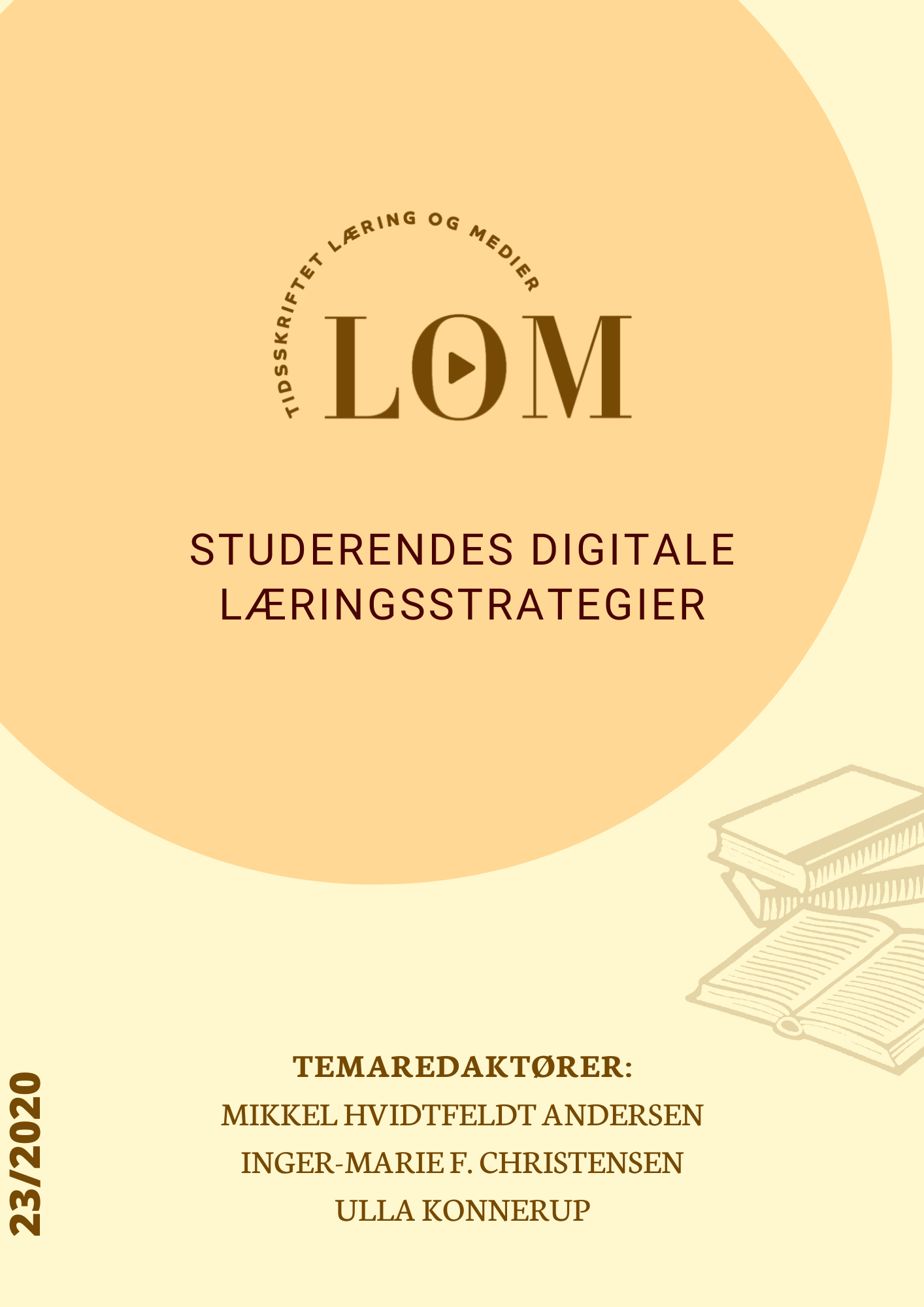
Students’ digital learning strategies
Vol. 13 No. 23 (2020)Mikkel Hvidtfeldt Andersen, IT-Universitetet
Inger-Marie F. Christensen, Syddansk Universitet
Ulla Konnerup, Aalborg University
In this issue of the journal Learning and Media, we focus on students’ digital learning strategies. We call for research-based articles that can contribute knowledge on the digital learning strategies employed by students enrolled in youth and higher eduction, and contributions that discuss who plays a role in strengthening students’ digital leaning strategies and how this can be done.Students’ use of digital technology in and outside of the classroom is a subject that many people take an interest in. Both teachers and students state that digital technology can be a disturbing influence. At the same time, students are reluctant to have to make do without their digital devices because notetaking by hand is too slow, offers no structure or search options, means a disconnection from their virtual, social networks, collaboration etc. The question is, however, whether students’ digital activities support their learning. The purpose of this issue is exactly to shed light on students’ practice not just in the classroom, but also before and after lessons and lectures – in formal as well as informel learning situations. We are interested in contributions that map, discuss, critically assess, how (new) digital technologies affect students’ digital learning strategies, their study technique and the quality of learning. Are students merely using digital technology in order to more effectively support traditional study activities, or have new digital learning strategies developed – and to what extent are these strategies linked to specific subjects and general student success respectively?
It is also interesting to shed light on the parties that can play a role in strengthening students’ digital learning strategies. What role does the institution play? What role does the teacher play? What role(s) can support units (libraries, student services etc.) play? What is the best place to strengthen students’ digital learning strategies – within or outside of subject-related contexts?
-
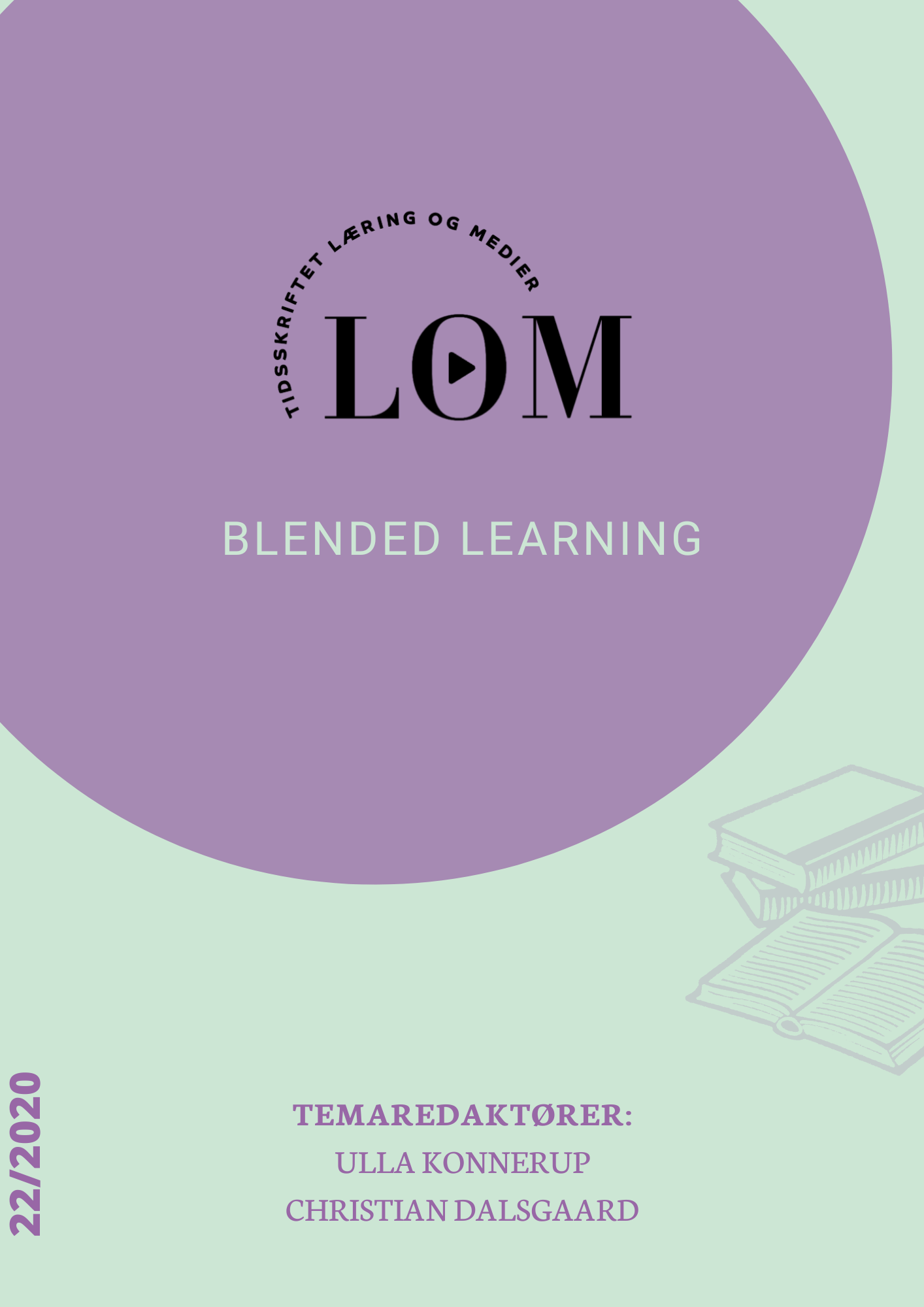
Blended Learning
Vol. 12 No. 22 (2020)Editor: Ulla Konnerup, ullak@hum.aau.dk, Aalborg Universitet.
Editor: Christian Dalsgaard, cdalsgaard@edu.au.dk, DPU, Aarhus Universitet.Blended Learning is a multifaceted field with links to concepts such as hybrid learning, flexible learning, multimodal learning and learning ecology. Common to these concepts is that they highlight a complexity within learning environments, where learning and teaching is supported and mediated by different technologies, and where different on/offline formats er thought together in courses. The concept of blended learning is often related to a social constructivist and experience-based learning and to learning in networks and communities. In this call blended learning is considered as a conscious redesign of courses that integrate different on/offline formats in a reflected manner - and not only integration of technologies as a supplement to traditional teaching.
Within the last 20 years, a variety of blended learning has been a part of the offers of educational institutions. Blended learning is considered as a contributor to educational diversity and as an enabler of access to knowledge and social interaction. Further, blended learning has the potential to offer flexibility and financial efficiency.
The concept "blended learning" describes a framework of physical and virtual learning environments more than a specific learning approach. However, which learning approaches relate to blended lerning formats?
-
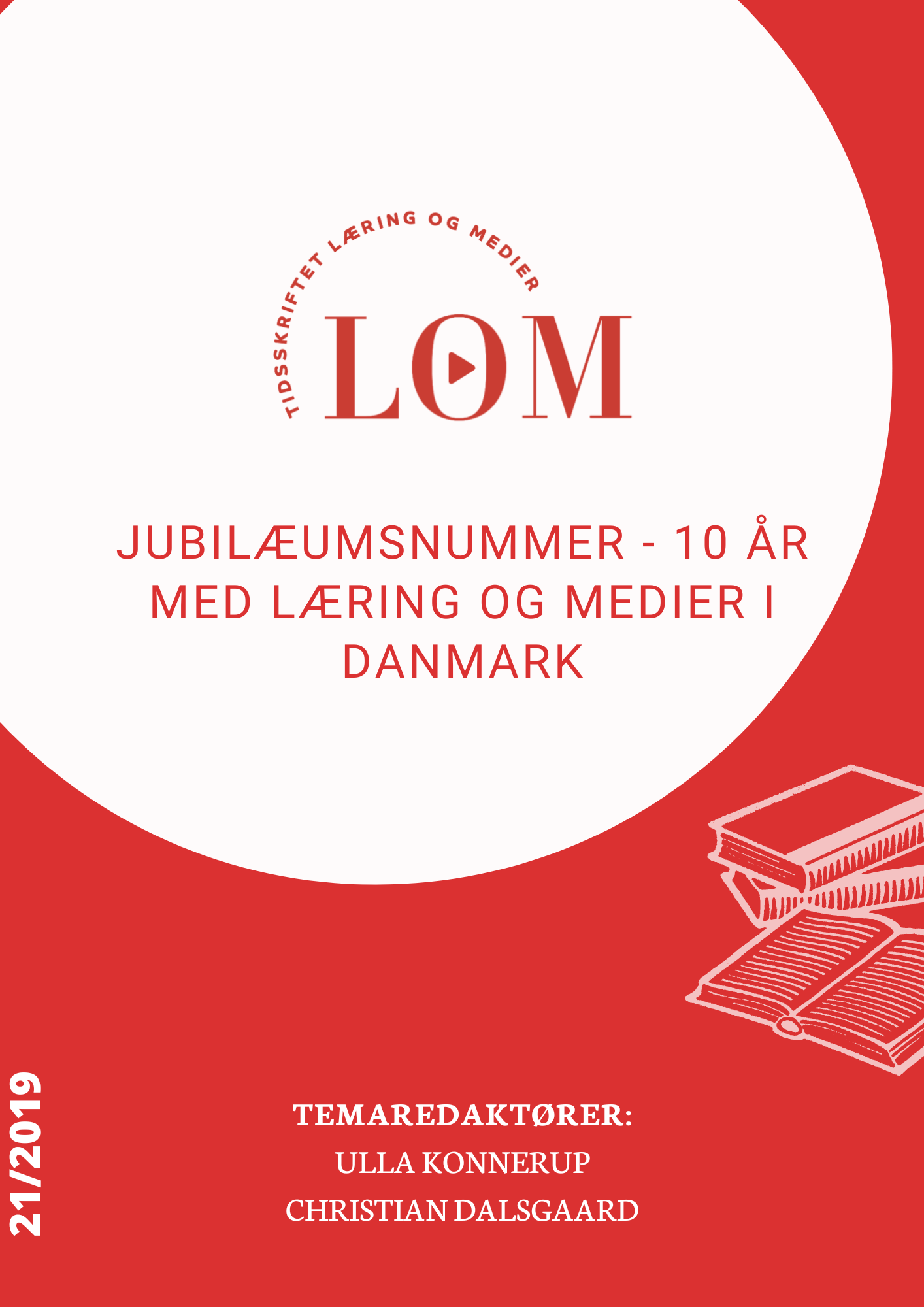
Anniversary issue: 10 years of Learning and Media in Denmark
Vol. 12 No. 21 (2019)Editor: Mikkel Godsk, godsk@au.dk Aarhus Universitet
Editor: Christian Dalsgaard, cdalsgaard@edu.au.dk, DPU, Aarhus Universitet
Editor: Lillian Buus, libu@via.dk, VIA University College
Editor: Inger-Marie F. Christensen, imc@sdu.dk, Syddansk UniversitetThe journal Learning and Media celebrates its 10th anniversary in 2018 and we take the opportunity to focus on selected themes in the field of technology and media in teaching and learning that have dominated the period and to contribute an updated state-of-the art. LOM (and before that UNEV) has, among other themes, brought into focus e-learning platforms, e-portfolios, feedback, learning design, robots, learning analytics, digital skills training, mobile learning, digital exams, virtual worlds, serious gaming, multimedia in teaching, research communication, policy, learning objects, continued professional education via e-learning, the organisation and management of e-learning and net-based language teaching and collaboration.
With this anniversary issue, LOM wishes to bring into focus selected key themes from the past 10 to 15 years. The anniversary issue will consist of authoritative articles by invited experts within each theme. This anniversary issue is also an open call to anybody who wishes to contribute to the themes listed below.
The themes selected for the anniversary issue are:
- Social media
- Video in teaching and learning
- Open education and open resources (OER, MOOC, PLE)
- Games and gamification
- Learning design
- Virtual worlds and VR/AR
The articles of the anniversary issue are to create an overview of key studies and investigations within the theme in a coherent presentation and take their point of departure in a small-scale literature review that also covers different approaches and concepts within the theme with a view to identifying and discussing key challenges and potentials.
-
Tilstedeværelse og flere virkeligheder
Vol. 12 No. 20 (2019)Technology creates opportunities to develop new spaces and presences. Simulations and perspective shifts challenge and allow for observation and experimentation. New generations of Virtual Reality (VR) technology surpass the boundaries of what was previously possible. The question is, what do we want to do with these technologies? Create simulations where we can safely explore the unknown and the unsettling? Develop new forms of gamification where learners immerse themselves in experiences that were previously the domain of imagination and big Hollywood productions?
Learning is about presence – we can create environments where we are simulated to be present in worlds we otherwise wouldn't have access to. We can choose and customize, but perhaps it's not about learning environments adapting to the individual. The learner should not only be offered a learning environment and path that suits their needs and potentials but should also actively participate in creating it. In situations where physical meetings are not possible, they need to be offered remote presence and be able to realize the possibilities of remote presence.
Two trends within computer-mediated environments can be distinguished: Blended Reality and Virtual Reality. With the recent developments in Virtual Reality (VR), new opportunities have arisen to deliver interactive content that provides increased immersion for users. We find ourselves in a blended reality, where we are present in multiple worlds - both in and on digital media and simultaneously in the physical world (Waterworth and Riva, 2015). The physical and digital layers can also be more literally mixed, such as when a virtual layer is overlaid onto physical reality, known as Augmented Reality (AR), as seen in applications like Pokémon GO.
-
Teknologiforståelse, digital dannelse og computational thinking
Vol. 11 No. 19 (2018)The technological development is both a condition and a framework for society in general and the education sector in particular. Therefore, many initiatives are currently being launched in the Danish education system. In high schools, "Computer Science" has been introduced as an elective and specialization subject. On an experimental basis, the Ministry of Education introduced the elective subject "Technology Understanding" for the upper levels of primary school in 2017. Additionally, the IT industry, in collaboration with various municipalities, has launched the Coding Class initiative, which involves more than 2700 primary school students nationwide. These initiatives are based, in part, on the need for a skilled workforce in the digital sector and the assumption that future society and the job market, in general, will require employees who possess technology understanding and more advanced IT skills. Today, students not only need IT skills but also need to be digitally literate. Digital literacy includes the ability to responsibly navigate and participate in shaping society, including through digital media, tools, and materials.
These initiatives highlight the need for knowledge to determine the role that IT should play in the education system and as part of future education and competencies.
-
Systemer, portaler og platforme mellem styring og frihed
Vol. 11 No. 18 (2018)Most Danish educational institutions have in recent years implemented larger IT systems and acquired new technologies to support their educational activities. These primarily include technological systems, portals, and platforms referred to as e-learning systems, learning portals, Learning Management Systems, Virtual Learning Environments, etc.
Within the field of upper secondary education and higher education, e-learning systems like Moodle, Fronter, itslearning, Lectio, Blackboard, and Canvas have been implemented. In the primary school sector, there is an ongoing initiative called the Brugerportalsinitiativet, which involves the implementation of a learning platform in all primary schools.
In this themed issue of the journal "Læring og Medier," we focus on the pedagogical and didactic implications of introducing such systems, portals, and platforms. In this themed issue, we seek to address the following issues:
- What is a learning portal or learning platform?
- What framework and opportunities do these technologies provide?
- How do these systems restrict and/or promote the pedagogical and didactic options for educators?
- Is there an inherent pedagogy/didactics in the systems, or does it need to be defined separately?
- Is there an "outsourcing" of pedagogical and didactic methods to system developers, or is pedagogy and didactics being redefined in new ways? -
Portfolio, refleksion og feedback
Vol. 10 No. 17 (2017)This issue of LOM (the Danish abbreviation for "Learning, Education, Media") focuses on the portfolio and its various applications in upper secondary education and higher education. We are looking for articles covering the breadth of potentials and support methods for the portfolio. We also welcome articles in a wide range of genres, including articles on existing experiences with the use of the portfolio method, reviews of research and books on the portfolio method, evaluations of its effects and quality in relation to educational challenges, pedagogical innovations, and experiments with the method, and more.
In recent years, the portfolio has become an integrated part of the education system at various levels, serving as a tool for learners to document and reflect on their understanding of their own learning. For educators, the portfolio can help create coherence and progression in teaching and provide insights into the learners' learning outcomes. As an evaluation tool, the idea behind the portfolio is to make learning visible in a broad sense and thereby open up for nuanced evaluation of the learner's development, as well as facilitate feedback.
Progression can be related to many aspects: the development of either subject knowledge within disciplines, across disciplines, or in different application contexts, or the development of more implicit knowledge such as socialization into the education system, well-being, or motivation. Furthermore, there are many different understandings of progression, with a central distinction between linear and planned progression on one hand and more process-oriented or circular progression on the other. The question is, therefore, what specific opportunities are associated with the portfolio.
Reflection is also a multifaceted concept with many subcategories or related concepts such as 'critical reflection,' 'reflective thinking,' 'reflective awareness,' 'self-reflection,' 'reflection in action,' 'reflection on action,' 'metacognition,' 'meta-learning,' etc. Once again, it is crucial to illuminate how the potential of the portfolio can be understood in relation to these concepts and what opportunities this provides.
The potential of the portfolio seems broadly grounded and can be supported by various technologies: blogs, wikis, virtual folders, dedicated portfolio tools, etc.
In this themed issue, we seek to address the following issues, preferably with evaluations of specific portfolio courses as a basis:
- Definition: What can a portfolio be, and what is its role in various pedagogical contexts? Applications: What are the possible applications of the portfolio as a form of learning, teaching, and assessment?
- Quality: What is the quality and effectiveness of the portfolio method for learning and teaching?
- Technology: What technologies support the creation and use of the portfolio, and what is the potential of different technologies?
- Integration of Feedback: Feedback can be organized in various ways – self-feedback, peer-feedback, teacher feedback – and can have different focuses – on achievements, processes, and developments within an academic field. How can feedback be integrated into the portfolio?
- Progression: How can the link between the portfolio and progression be understood?
- Reflection: How is the learner's reflection supported in portfolio courses, and what is the significance of reflection for the learning outcome? -
Learning design i praksis – cases og erfaringer fra online- og blended learning
Vol. 9 No. 16 (2016)This issue of LOM (the Danish abbreviation for "Learning, Education, Media") focuses on learning design in practice, including examples of new ways to think about pedagogy, didactics, methods, and learning environments. With reforms throughout the education system, the focus has shifted from teaching to learning, and there is an increased emphasis on the digital dimension. There is now a greater focus on whether students meet learning objectives rather than the teaching methods that underpin the achievement of those objectives. Therefore, teaching is no longer primarily about conveying subject matter but rather about creating learning environments that place the student at the center of their own learning in an active, investigative, and practical way. This paradigm shift has led to a focus on methods such as learning objective-driven instruction, flipped learning, multimodal learning designs, and more.
-
Learning design: pædagogiske og didaktiske modeller for undervisningsudvikling, kvalitetssikring og effektivisering på de videregående uddannelser
Vol. 9 No. 15 (2016)This issue of LOM (the Danish abbreviation for "Learning, Education, Media") focuses on learning design and other model-based approaches to curriculum development, which are increasingly gaining popularity at both foreign and Danish educational institutions. The model-based approach has proven useful in quality-assuring the use of technology in education, concretizing pedagogical theory into tangible models and tools for curriculum development, targeting educators, and enabling the reuse and sharing of best practices. Furthermore, this approach holds potential in a business context, as curriculum development can be systematized, thereby realizing technology's potential for improved quality in education and efficiency.
With the recent reforms in the education system, the focus has shifted from teaching to learning, while also placing a greater emphasis on the digital dimension. There is a heightened focus on learning objectives, and the political agenda underscores that educational institutions should produce more high-quality graduates with fewer resources.
In this issue of LOM, we emphasize learning design and other model-based ways of thinking about pedagogy, methods, and learning environments in higher education. Therefore, we invite articles on existing experiences with the use of learning design and pedagogical/didactic models, reviews of research in the field, and articles on new models for e-learning and methods targeting specific challenges such as differentiation of instruction, remote learning design, and skill development. Additionally, we welcome articles of a more business and strategic nature, including contributions that address the quality and economic potential and consequences of introducing learning design and pedagogical models in higher education.
-
Robotter
Vol. 8 No. 14 (2015)Editor: Niels Henrik Helms, UCSJ
Editor: Gunver Majgaard, Syddansk UniversitetIn this issue of LOM (the Danish abbreviation for "Learning, Education, Media"), we focus on how robots and robot technology are currently integrated and can potentially be integrated into welfare and learning contexts. Robots represent a unique materiality with potentials that both spark fascination, concern, and even fear. We invite a broad discussion in which contributions covering various aspects of learning and interaction with robots can illuminate the diversity and areas of interest within this field.
-
Kvalitet i IKT-støttede læringsmiljøer & learning analytics
Vol. 8 No. 13 (2015)This issue of LOM (the Danish abbreviation for "Learning, Education, Media") focuses on quality in ICT-supported education and the application of learning analytics at universities and University Colleges (UCs).
With the latest reforms in the education sector, including the recent reform of primary education, there is increasing emphasis on what we know about the quality of education. This includes evidence of the effectiveness of different instructional methods on one hand and documentation of individual students' progress on the other hand. In higher education, we have also seen the emergence of various (new) expressions of quality criteria embedded in educational accreditations.
-
Digitalisering af færdighedstræning og laboratorieøvelser
Vol. 7 No. 12 (2014)Editor: Peter K. Fridorff-Jens, København Universitet
Editor: Cita Nørgaard, Syddansk Universitet
Editor: Mads Ronald DahlPhD, Aarhus Universitet
In this themed issue, the focus is on sharing experiences and best practices in digitizing skill training and other forms of media integration in simulation and laboratory environments within the fields of natural and health sciences as well as technical sciences. -
Fremtidens undervisningsmiljøer
Vol. 6 No. 11 (2013)Editor: Uwe Wollin, Cophenhagen University
Editor: Lillian Buus, VIA University CollegeThis issue of LOM (the Danish abbreviation for "Learning, Education, Media") focuses on the future learning environments at universities and UCs (University Colleges). By "future learning environments," we are referring, among other things, to the use of digital media in education and how they are integrated with the physical settings for teaching. This integration aims to incorporate virtual spaces into physical ones and/or bring physically separate teaching spaces together into a shared learning environment. Another perspective on "future learning environments" currently gaining attention is Massive Open Online Courses (MOOCs), but there are also interesting prospects within alternative designs of physical teaching or study environments.
-
Mobil teknologi i universitetsundervisningen
Vol. 6 No. 10 (2013)Editor: Inger-Marie F. Christensen, Syddansk Universitet
Editor: Mikkel Godsk, Aarhus UniversitetIn this issue of LOM (the Danish abbreviation for "Learning, Education, Media"), we focus on mobile technology as a facilitator and driver for learning and educational development at universities.
Mobile technology is a rapidly evolving field, and the proliferation of smartphones is on the rise. At the turn of the year, 43% of all Danes had a smartphone, and more and more students are now investing in iPads, e-book readers, and other digital gadgets. This presents entirely new challenges and opportunities for university education because, although technology is fascinating and exciting, it is not always clear how it can be best utilized for teaching, learning, and evaluation activities. This issue of LOM seeks to shed light on this matter, and therefore, we are seeking experiences with the development and implementation of devices, gadgets, and various mobile technologies in university education.
-
Spil i undervisningen/ELYK-projektet
Vol. 5 No. 9 (2012)Editor: Michael Pedersen
Editor: Steffen Löfvall
Editor: Christian Dalsgaard
Editor: Jørgen Bang -
Evaluering og eksamen i en digital verden / Assessment and exams in a digital world
Vol. 4 No. 7/8 (2011)Editor: Rasmus Blok, Aarhus Universitet
Editor: Marie Gottlieb, IT-Universitetet.Evaluation and examinations have always been core components of higher education and have garnered increasing interest in the past decade, both in terms of their role and function. There has been a general debate about the purpose of evaluation and examinations and for whom they are most beneficial, as well as a more specific debate about how and to what extent we assess students, including how assessment methods are aligned with students' learning processes. On one hand, there is an argument that evaluation and examinations should be used more actively (formatively) as part of students' learning processes, and on the other hand, there is a view that evaluation and examinations should primarily serve as control mechanisms for the educational institution that awards degrees. In recent times, political demands for increased enrollment of students, as well as the general digitization of higher education, have once again intensified the focus on this area and rekindled the debate about goals, alignment, and the role of evaluations and examinations.
How can evaluation and examination, as well as the surrounding processes, be best transformed for the digital age of students and adapted to higher education? And how can we (and should we) protect examinations and students from the new opportunities for cheating that arise with the increasing use of new technology?
-
Fremme af IKT-støttet læring i forbindelse med den nationale strategi
Vol. 3 No. 6 (2010)Editor: Simon Heilesen, Roskilde Universitet
Editor: Uwe Wollin, Københavns Universitet
Editor: Helle Meldgaard, ForskningsnettetIn this themed issue, the contributions consist of experiences from the projects that received support from the Ministry of Science's fund to promote ICT-supported learning at universities in 2007.
-
Læring i videnssamfundet. Om vidensformidling, videnskonstruktion og vidensdeling
Vol. 3 No. 5 (2010)Redaktør: Christian Dalsgaard, cdalsgaard@edu.au.dk, DPU, Aarhus Universitet
Redaktør: Jens Jørgen Hansen, jjh@sdu.dk, Syddansk UniversitetEn antologi der fremlægger resultaterne fra forskningsprojektet Videnskonstruktion, vidensdeling og vidensformidling i videnssamfundets uddannelsessystem under Det Humanistiske Fakultets satsningsområde Videnssamfundet. Antologien er inddelt i tre temaer:
1. Sociale medier
- Simon B. Heilesen: E-læring 2.0. Vilkår og muligheder i det sociale web
- Marianne Riis: Mon Wenger har en avatar? - observationer og refleksioner over remediering af didaktisk design i Second Life
- Christian Dalsgaard: Internettet som personaliseret og socialt medie
- Jørgen Bang: Den digitaliserede kulturarv - en læringsressource med stort potentiale!
2. Medier i undervisningen
- Bo Fibiger: Mobile mediers læringspotentialer - didaktiske overvejelser i forbindelse med brugen af podcast og vodcast
- Ben Bachmair, John Cook og Norbert Pachler: Mobiltelefoner som kulturelle ressourcer: En analyse af mobil ekspertise, strukturer og spirende kulturelle praksisser
- Judith Seipold: Kan brugen af mobiletelefoner i undervisningen styrke elev-centrerede læreprocesser?
- Klaus Rummler: "Udsatte elevers" livsstil: Indbyrdes afhængigheder mellem mønstre for mediebrug og læring i "udsatte" ungdomskulturer
- Jørgen Bang, Christian Dalsgaard og Thea Skaanes: Kan mobiltelefonen skabe refleksion i undervisningen? Medialisering som refleksivt redskab
3. Medier i undervisningen
- Helle Mathiasen: Brug af podcasts i undervisningen - muligheder og begrænsninger
- Ole Caprani og Klaus Thestrup: Det eksperimenterende fællesskab: Børn og voksnes leg med medier og teknologi
-
Perspektiver på e-læring
Vol. 3 No. 4 (2010)Editor: Jørgen Gomme, Københavns Universitet
Editor: Tom Nyvang, Aalborg UniversitetPerspectives on e-learning is a very broad theme, as there can be many perspectives applied to e-learning. To name just a few, one can focus on institutions and organizations' internal organizational support for e-learning, pedagogical and didactic approaches related to e-learning, and, importantly, the utilization of new opportunities to reach new target audiences that e-learning also offers. Next comes the question of what e-learning is. Here, we have a broad perspective and include all ICT (Information and Communication Technology) support for learning. Another recurring theme related to e-learning is change - the transition from not using e-learning to adopting it or changing the way e-learning is utilized.
-
Læringspotentialet i virtuelle verdener
Vol. 2 No. 3 (2009)Editor: Rasmus Blok, Aarhus University
Editor: Inger-Marie F. Christensen, imc@sdu.dk, Syddansk UniversitetVirtual worlds have been a highly debated topic in recent years. While many have seen a whole new world of possibilities in relation to education and learning, others have expressed skepticism about their learning potential.
This themed issue will feature both theoretical and experience-based articles on the learning potential of virtual worlds and attempt to shed light on the actual potentials and challenges.
The technological scope encompasses virtual worlds, 3D learning games, and similar technologies and is therefore not limited solely to Second Life.
-
Implementering af lyd, video og interaktive medier i undervisningen
Vol. 2 No. 2 (2009)Editor: Christian Dalsgaard, cdalsgaard@edu.au.dk, Aarhus Universitet
Editor: Mikkel Godsk, godsk@au.dk, Aarhus UniversitetThe use of audio, video, and interactive media in education is experiencing significant growth in higher education. Podcast technology is considered useful and an open distribution channel for lectures in many places, while video conferencing stands out as a flexible and environmentally friendly technology.
The articles document both positive and less favorable experiences with these technologies, as well as theoretical reflections and research. The articles indicate a diverse use of audio, video, and interactive media in education, with particular emphasis on the investment in video as an area of focus.
-
Forskning og kommunikation
Vol. 1 No. 1 (2008)Editor: Simon B. Heilesen, RUC
Editor: Michael Pedersen, CBSThe dissemination of scientific knowledge is increasingly prominent in higher education. It has become a natural task, and furthermore, it is an indisputable requirement that the staff make their knowledge available to society, as stated in the Universities Act of May 28, 2003.
-
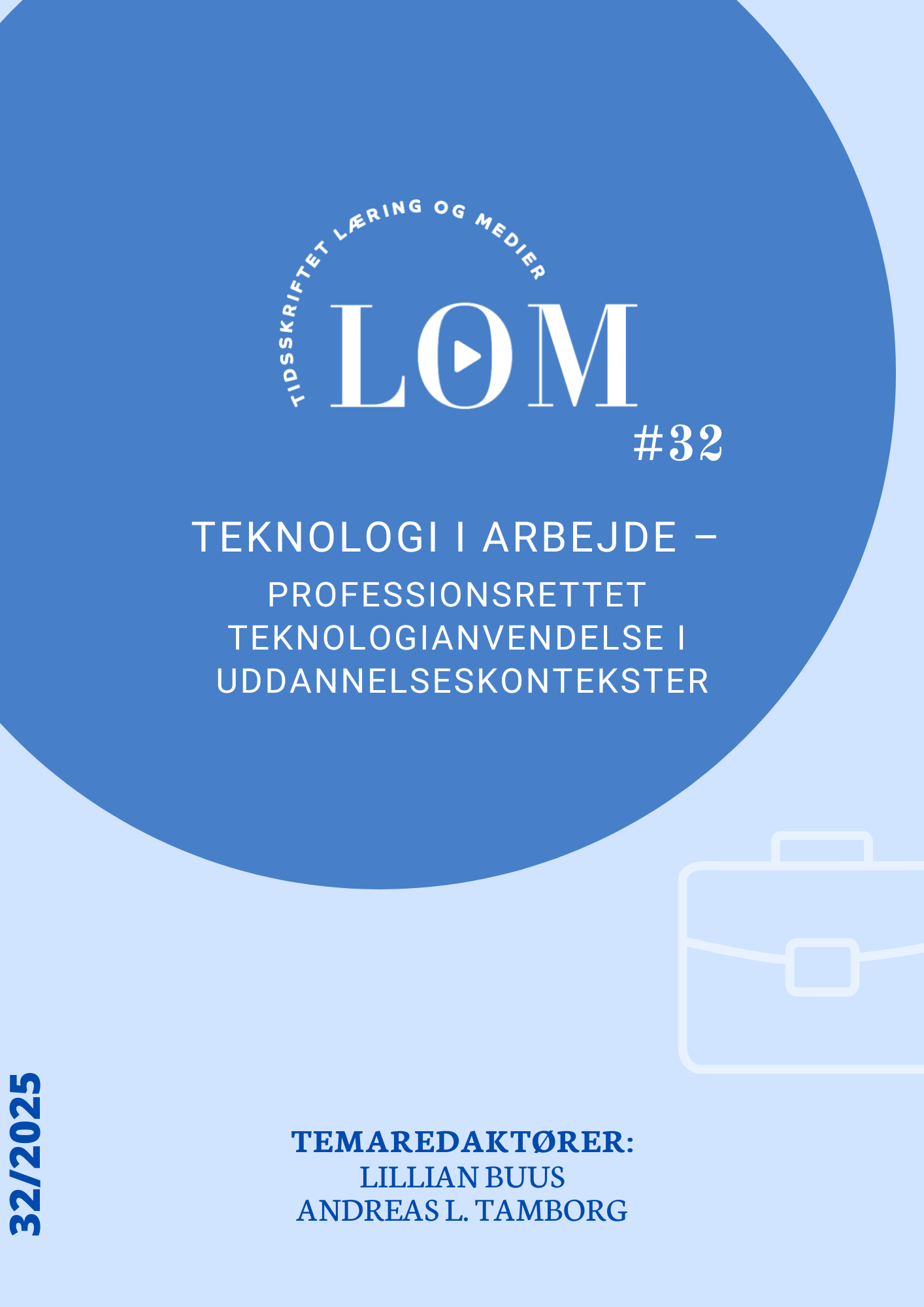
Technology at Work – Profession-Oriented Use of Technology in Educational Contexts
Vol. 18 No. 32 (2025)Technology plays a significant role in society and modern working life, and it is also crucial in many of the professions for which we educate in Denmark. For instance, the report on Denmark's digital growth[1] from the Danish Ministry of Industry, Business and Financial Affairs mentions artificial intelligence, robots, the Internet of Things, and big data as some of the most important advanced technologies making their way into working life these years. The spread of technologies has notably changed working life in a wide range of areas in the public sector, including healthcare, education, and administration. These developments place new demands on how (profession-oriented) education educates and reskills future graduates and the existing workforce to engage with and contribute to this reality. In the use of artificial intelligence, big data, as well as robots, Denmark is around or above the median in the EU, making it relevant to examine how profession-oriented study programs work to meet this new reality. What role should the use of technology play in profession-oriented teaching, competence development, and learning processes? How can technologies be didactically designed to reflect a profession-oriented reality? Are technologies used to support learning, i.e. something to learn with, or are they learning objects and rather the subject of learning, or perhaps both?

